Affiliate disclosure: This post may contain affiliate links. Please see our Privacy Policy.
Pumpkin season only comes once a year, but with so many ways to preserve pumpkin there’s no reason it can’t stick around. Even before fall officially arrives, the majority of us are anticipating all things pumpkin. Whether it’s grandma’s traditional pie or carving a frightening face into its flesh, pumpkin season can’t get here fast enough. Preserving pumpkin at home means that much anticipated season can last just a bit longer!
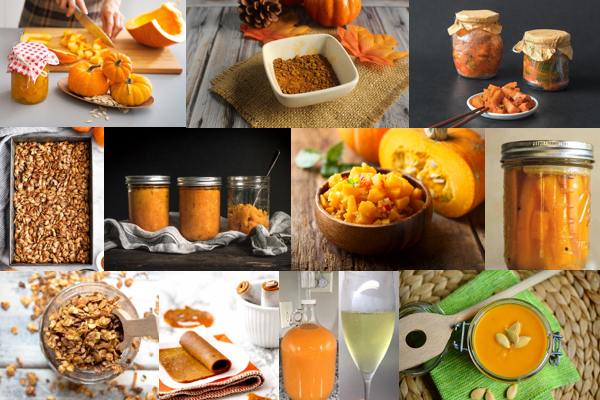
Pumpkins originated in North America and were used by Native Americans as an essential part of their diets. They would roast large strips of pumpkin over a campfire and bake, boil, dry, or roast the inner pulp before consuming.
All of this was done long before the Pilgrims set foot on Plymouth Rock and discovered this delicious squash for themselves. These early settlers began using the pumpkin like we do today, in baked goods, stews, and desserts.
Pumpkins are so much more than soon-to-be jack-o-lanterns and rightfully so. They’re loaded with vitamins, minerals, and antioxidants. What’s more, this nutrient-dense winter squash is low in calories, making it a great choice if weight-loss is your goal.
With all of these incredible health benefits, you might be wondering how to preserve pumpkin for the colder months ahead.
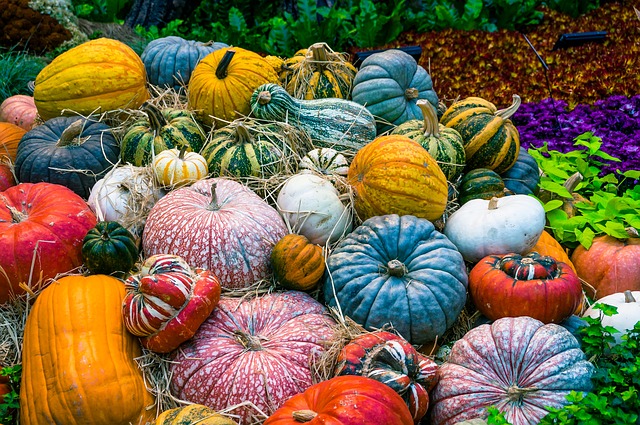
Root Cellaring
I love old-fashioned root cellaring as a way to preserve all kinds of produce from apples to onions to potatoes. Building a root cellar on your homestead is a great idea when thinking about storing your fall harvest and probably the easiest way to preserve pumpkin or other winter squashes.
To avoid spoilage, keep a few inches of your pumpkin’s stem attached and avoid storing any squash with bruising or rot. Curing is necessary to harden the skin prior to cellaring them. Cure in a warm place, 80-85°F for about 10 days. After curing, place your squash in your root cellar’s driest area.
A good root cellar temperature for pumpkin can range between 45-55°F. Because some may keep better than others, it’s a good habit to check them regularly and remove any that appear soft or rotted. Root cellared squash has the ability to last for several months as long as they’re kept cool and dry.
Because not everyone has a root cellar on their property, you can replicate the cold conditions needed to preserve your produce in a dedicated area of your home that maintains a temperature below 60°F. Try storing your winter squash in your unheated attic, on your porch, or in a ventilated shed or garage.
I’ve kept pumpkins in my unheated entryway/mudroom for 8+ months with no special care of attention. We slowly ate them all winter long, and then I left the last one in there just to see how long it’d make it. When we harvested the first early honeyberries and everbearing strawberries from the garden in June, I went ahead and ate it before summer temperatures heated up.
Who knows how long it would have lasted, it might have made it a whole 12 months in cool storage…
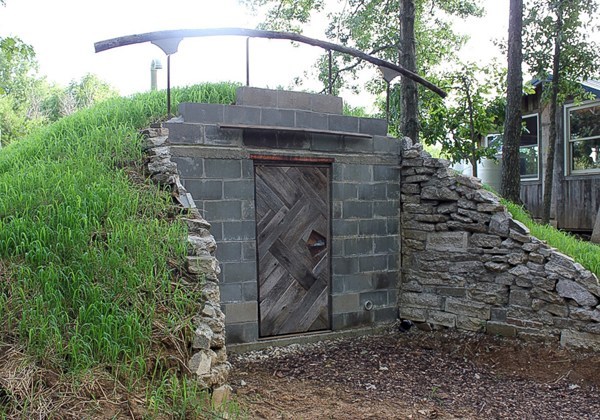
Drying Pumpkin
Historically, Native American tribes used drying as a technique to preserve pumpkin. They also dried the outer shells of various squashes to use as bowls, water vessels, and for storage. Peter Kalm, a Swedish botanist who explored the wilds of Northeastern America, wrote in 1749:
“The Indians, in order to preserve the pumpkins for a very long time, cut them in long slices which they fasten or twist together and dry either in the sun or by the fire in a room. When they are thus dried, they will keep for years, and when boiled they taste very well. The Indians prepare them thus at home and on their journeys.”
Through modern technology, we can still implement this traditional method of preservation with help from a super-efficient home dehydrator. Dried pumpkin chunks are great added to soups and stews, but there are even tastier ways to dehydrate pumpkin these days…
Pumpkin Fruit Leather
One option is to make tasty, chewy, dried fruit rolls. After you’ve pureed your pumpkin, turn it into pumpkin fruit leather by dehydrating on the lowest setting of your machine.
You can test for doneness by touching the center of your leather. If an indentation is left behind, it’s not ready yet!

Pumpkin Powder
Another common way Native Americans preserved grains and squash was by grinding their dried produce into a rich powder to use later in cakes and stews. You can make your own pumpkin powder by dehydrating puree and grinding it finely in a coffee or spice grinder.
Though it sounds pretty niche, pumpkin powder is incredibly versatile. Using dried pumpkin as a seasoning powder puts actual pumpkin into your pumpkin spice-flavored dishes. It’s also great for making crisp baked goods that don’t do well with added pumpkin puree.
Pumpkin cookies, for example, are notoriously cakey. Though I’ve yet to test recipes, I’d imagine by using pumpkin powder you could make a truly spectacular crisp pumpkin chocolate chip cookie…
Try using it in smoothies, over pasta, or even to make pumpkin pie from dehydrated pumpkin powder!
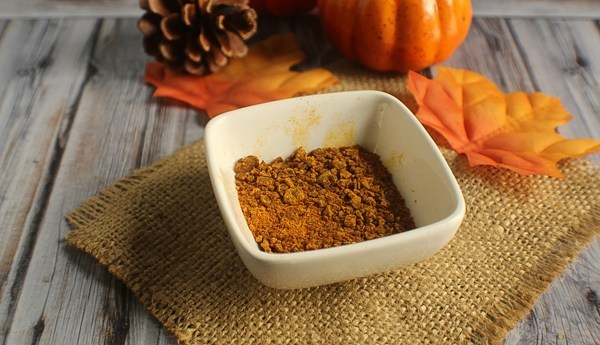
Dehydrated Pumpkin Chips
Why have I never seen pumpkin chips at my local grocery store? Sweet potato chip, beet chips and all manner of other veggie chips, but pumpkin chips still haven’t made it mainstream.
Pumpkin chips are a lot like sweet potato chips, delicious and crispy, with a warm flavor and just enough sweet. Not only that, but they last pretty much forever!
Season your chips however you like (chai spice, anyone?) and dehydrate. Simple enough!
Dehydrated Pumpkin Seeds
When you actually think about the volume of a pumpkin, most of it is actually the seeds rather than the flesh. Pumpkin seeds, or pepitas as they’re often called, are not just another layer of waste for your compost bin. High in protein, magnesium, and iron, it would be a crime to toss these healthy seeds!
To dry pumpkin seeds, use your oven to make cinnamon sugar pumpkin seeds. Add them to your trail mix, granola, or as a topping to your favorite yogurt!
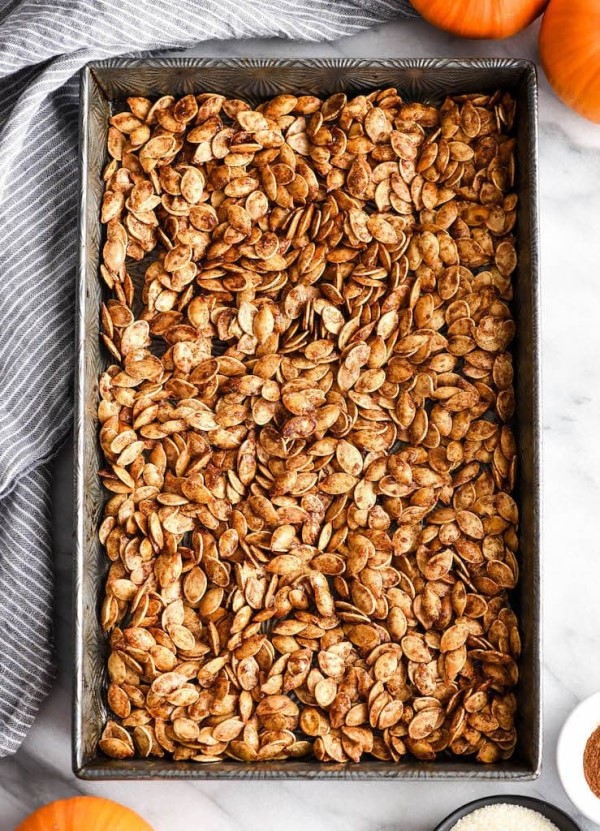
Pumpkin Granola
Granola is a magical substance in my opinion, and it’s amazing how it can transform many different ingredients into a crispy, shelf-stable, pop-in-your-mouth snack. All the ingredients are mixed together and then toasted in the oven, basically sterilizing and dehydrating them at the same time. Keep the granola in an airtight container and it’ll last for many months.
While I love homemade granola, it never occurred to me to make pumpkin granola! I just found a recipe for pumpkin granola that includes a full cup of pumpkin puree and is maple-sweetened to really bring out the fall flavors.
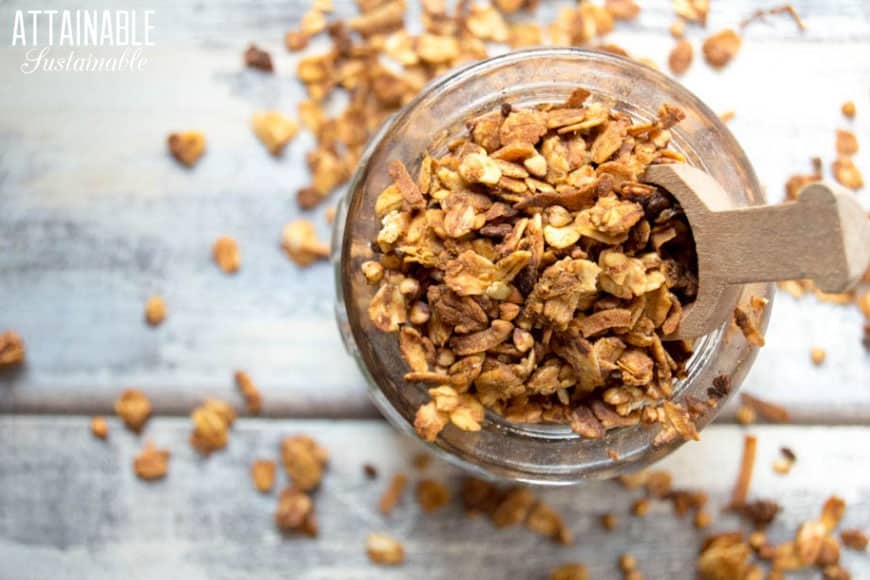
Freezing Pumpkin
Freezing as a food preservation method has been around for a long time and was taken advantage of if you were living anywhere that freezing temperatures occurred at some point during the year. But it was only in the 1800s that mechanical refrigeration was invented and allowed more people to use this preservation technique in the convenience of their own homes.
Pumpkin can be frozen for long-term storage for up to one year before it starts to affect its flavor. Try freezing your puree, butter, syrup, baked goods, and more!
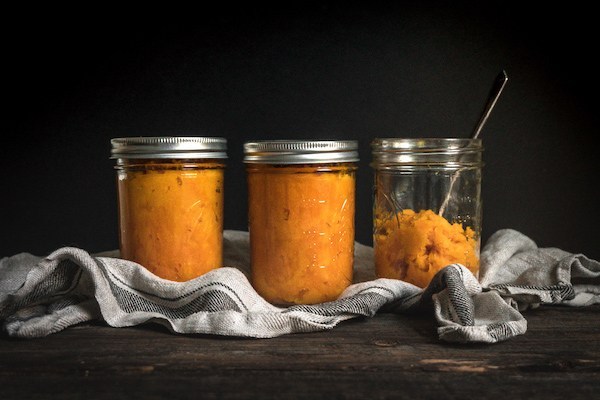
To freeze pumpkin, start by cooking it. I’ve tried chopping raw pumpkin, butternuts and other winter squash into cubes and freezing them in large storage bags….big mistake.
Freezing raw pumpkin causes it to turn rubbery, and the texture is bad that I ended up feeding the whole batch to my chickens. Beyond just texture issues, all that extra surface area exposes more of the squash to potential freezer burn.
Freezing Pumpkin Puree
The best way to freeze pumpkin is as pumpkin puree. I pack it into freezer-safe straight-sided wide mouth mason jars because I personally don’t like freezing things in plastic if I can avoid it. Freezer-safe mason jars work great, and they’re convenient for defrosting either in the fridge or in a basin of warm water in the sink.
Making pumpkin puree is super easy and can be done with any winter squash of your choice. Start by roasting your squash until it’s very soft.
If your pumpkin is smaller, you can even cook it whole in an Instant Pot! When it’s fully cooked, simply use it right away in any recipe that calls for pumpkin puree or freeze it for later use.
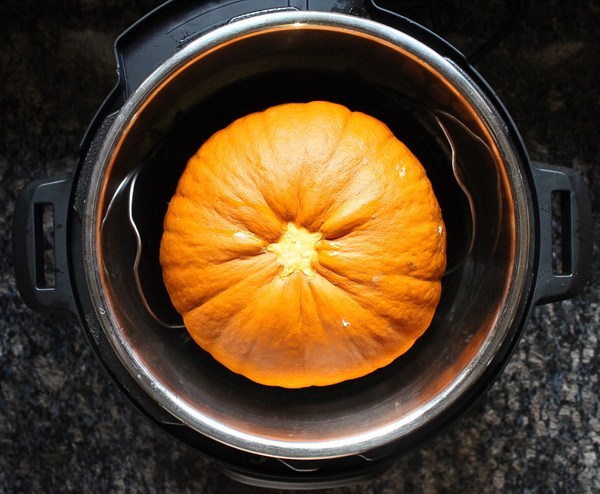
Freezing Pumpkin Pie or Cheesecake
Believe it or not, pumpkin pie and pumpkin cheesecake freeze beautifully! Preserving pumpkin in a ready-made baked good means that you save time later on, and you have a meal (or dessert in this case) ready to go on short notice.
When we were making a living selling baked goods at farmer’s markets I’d bake cheesecakes in bulk ahead of market day. Though I generally try to avoid freezing things in plastic, cheesecakes are an exception.
They need to be tightly wrapped in several layers of plastic wrap to stay fresh. Once frozen, the cheesecakes are like bricks and are so much easier to transport.
I’d stack frozen cheesecakes into the back of the car like cordwood, and they’d hold up beautifully until we reached the market. On arrival, unwrap and box them in a fancy pastry box and they’re ready to go.
Pumpkin cheesecake takes about 1 hour to thaw at room temperature, and more like 4 hours to thaw in the fridge. That means they stayed frozen just long enough for easy transport but thawed on my market table before the first customer arrived.
I’d bake them up once a month, and then take some different markets throughout the month. Frozen cheesecake and pumpkin pie will last for several months without losing quality if kept tightly wrapped.
Try making my favorite recipe for easy pumpkin cheesecake and you’ll be ready for a last-minute potluck anytime!
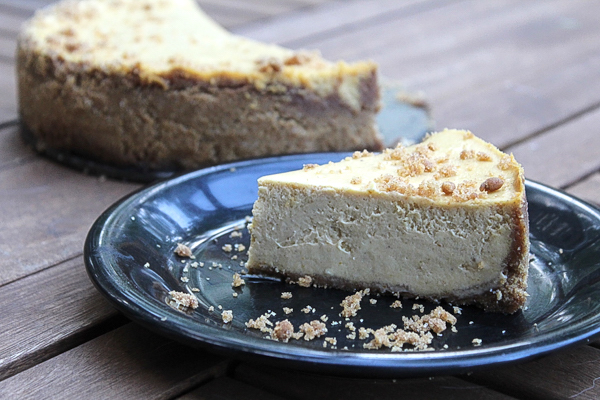
Freezing Pumpkin Soup
Generally, when I think of freezing a ready-made pumpkin-based meal, my mind goes to pumpkin soup. We do, in fact, freeze about a dozen freezer-safe mason jars full of pumpkin soup each fall.
They’re a quick and easy meal, and they even work pretty well as a meal on the go. Just grab the jar and it’ll stay cold most of the day in a lunch bag. Provided you have a way to heat it, it makes a great comfort food work lunch.
This year, I’m hoping to branch out a bit and try freezing other pumpkin-based soups. There are so many options out there!
I’m going to convert this thai carrot ginger soup to pumpkin (and add in coconut milk for extra richness), and I found a recipe for Pumpkin Beef Stew that looks amazing.
Both of those should make perfect pumpkin freezer soups, and bolster my stock of ready-to-eat meals this winter.
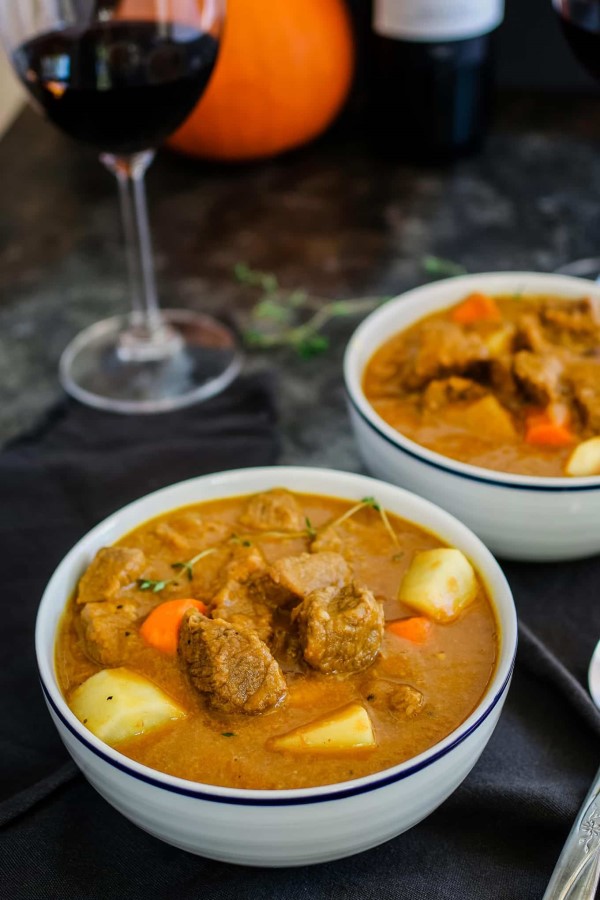
Freezing Pumpkin Butter
Most people think of homemade pumpkin butter as a canned good, but believe it or not, pumpkin butter is actually not approved for canning. Pumpkins are a low acid fruit, and it takes a lot of added acidity to make them safe for water bath canning. Add in the fact that pumpkin is really thick, especially when it’s cooked into pumpkin butter, and the thickness means it’s not approved for pressure canning either!
If you’re going to can a fruit butter, stick to canning apple butter at home. Homemade pumpkin butter can be kept in the fridge for a few weeks, but it’ll last months in the freezer.
Typically a butter is any fruit cooked to a paste and then sweetened. Using winter squash this way works great, can easily be frozen for use later in the year, and tastes heavenly. Try it smeared on a muffin, on top of pancakes, or added to your favorite fall smoothie!
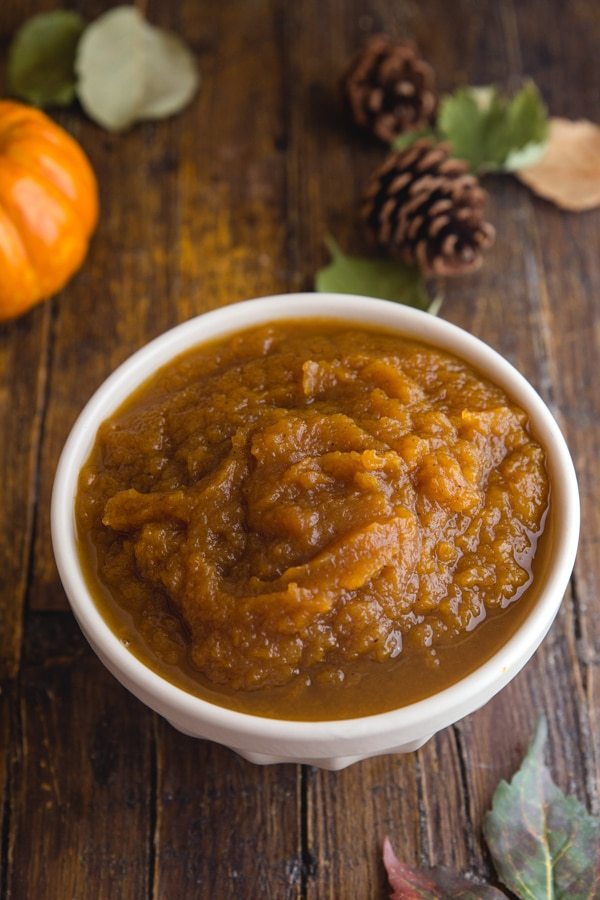
Pumpkin Syrup
It was only 50 years ago that the masterminds at McCormick started selling a blend of ginger, nutmeg, allspice, and cinnamon. What did they call it? Pumpkin Spice, of course!
Today, pumpkin spice products make up $500 million annually in sales almost entirely during the fall season!
With pumpkin spice and everything nice you too can make this an easy pumpkin syrup! I like to make a large batch and freeze half to use throughout the winter. Try it drizzled over waffles, toast, or in a homemade pumpkin spice latte!
Though canning pumpkin puree products is a big no-no according to the national center for food preservation, this one might be an exception. Given that it’s mostly a syrup, I’d imagine you could probably get away with canning this homemade pumpkin syrup to free up some freezer space. There’s no tested recipe, of course, so if you do choose to can instead of freeze you’ll have to do your research and do it at your own risk.
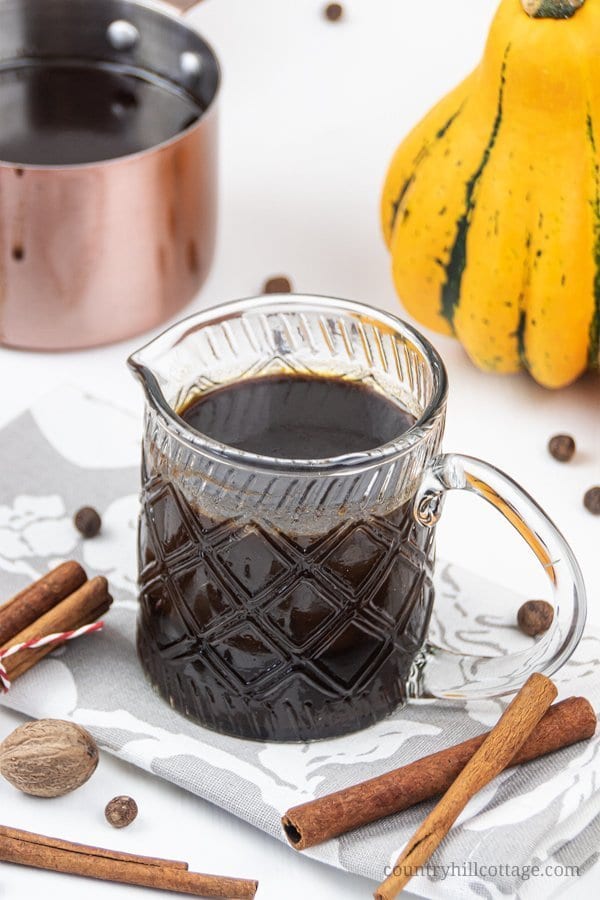
Freezing Pumpkin Bread and Muffins
You’re not limited to only freezing purees, try preserving various baked desserts like pies or scones using this method of long-term food storage. I’ll bake batches of 3 to 6 loaves of pumpkin bread at a time, tightly wrapping each loaf once it’s cool.
Frozen pumpkin baked goods will last at least 3 months without losing quality, and I’ve found some at the bottom of my freezer 6 months later that my family still demolished.
These pumpkin almond butter muffins are easy to freeze and thaw individually each morning when you’re in the mood for a warm, savory, pumpkiny baked good.

Fermenting Pumpkin
Fermentation is one of the oldest forms of preservation it should come as no surprise that pumpkin too can be fermented in various ways. Lacto-ferments, as well as alcoholic ferments, are perfect for preserving pumpkin.
Lacto-fermented Pumpkin Spears, Syrup and Chutney
Slightly tangy and surprisingly delicious, lacto-fermented pumpkin is a vitamin-rich probiotic treat. While sauerkraut is the best-known lacto-ferment, you can in fact ferment just about anything. Lacto fermentation results when harmful bacteria that are unable to tolerate salt are destroyed by health-promoting, good bacteria called Lactobacillus.
Fermentation occurs easily in warmer areas of the world, but there are ways to ferment in cold climates if, like me, you endure winter for half the year.
Sweeter winter squash varieties like Hubbard, butternut, red Kuri and kabocha are excellent choices for fermentation. Try adding spices like cardamom and ginger to give your ferment a warming flavor profile that pairs perfectly with winter squash.
You don’t have to stop there, try a lacto-fermented pumpkin spice syrup or lacto-fermented squash chutney.
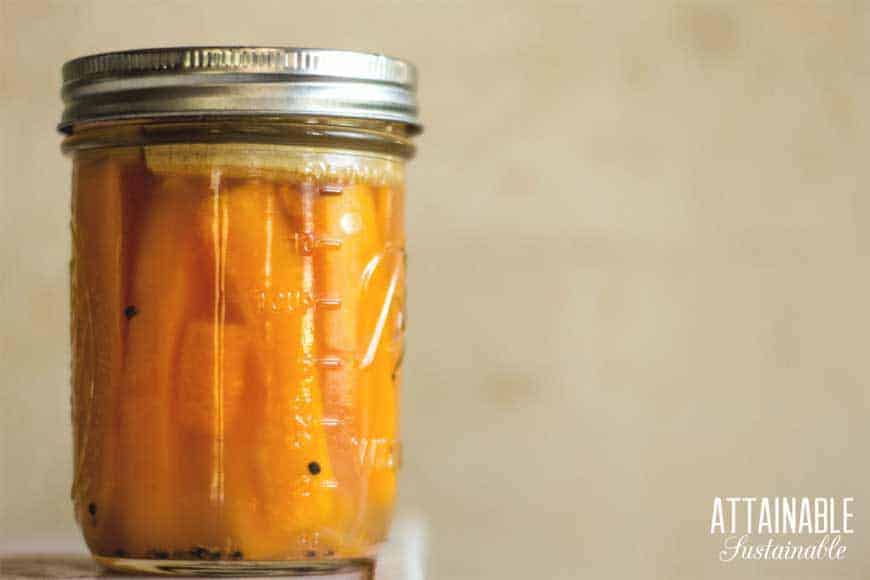
Pumpkin Kimchi
Seriously, pumpkin kimchi? Kimchi is a way of life in Korea, and it even has its own museum in Seoul. The museum exhibits talk of 187 officially documented varieties of traditional kimchi, which proves just how versatile kimchi can be.
As a traditional lacto-ferment, pumpkin kimchi will keep for many months without refrigeration. Over time, it’ll get stronger in flavor, so if you want to slow things down a bit refrigeration is a good idea, but it’s not strictly necessary for preservation.
Pumpkin kimchi starts by salting the pumpkin overnight, and then it’s mixed with other traditional kimchi ingredients to create a versatile condiment that’s almost fit for a meal all on its own.
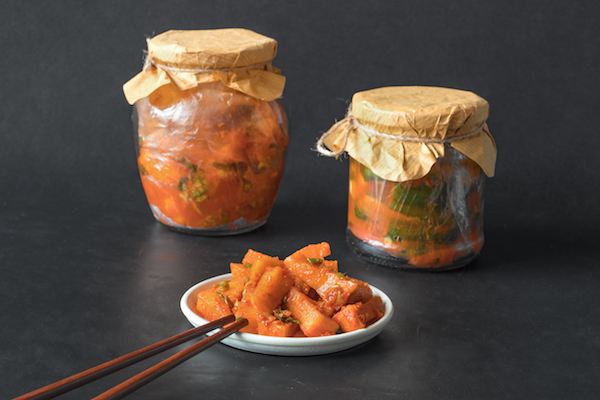
Pumpkin Beer, Wine, and Mead
Did you know you can basically turn any sweet fruit or vegetable into wine? So cool even a Pilgrim could do it!
No seriously, according to History.com’s article, Some Pumpkins, early colonists were all about making fermented alcoholic beverages with none other than their beloved pumpkin:
“Colonial Americans also drank their pumpkin. An enterprising person can make an alcoholic beverage out of almost anything, and the Pilgrims seem to have been first to make pumpkin beer or ale. A later stanza of the poem quoted above provides evidence that they were versatile with their ingredients:
If Barley be wanting to make into Malt, We must be contented and think it no Fault, For we can make liquor to sweeten our Lips Of Pumpkins and Parsnips and Walnut-Tree Chips.
The Pilgrim recipe was said to involve a mixture of persimmons, hops, maple syrup, and, of course, pumpkin. Further south in Virginia, planter Landon Carter mentions pumpkins in his diary in 1765. He, too, concocted some sort of alcoholic beverage from fermented pumpkins. He christened it pumperkin.
Perhaps he used a method similar to an anonymous recipe of 1771:
Let the Pompion be beaten in a Trough and pressed as Apples. The expressed juice is to be boiled in a copper a considerable time and carefully skimmed that there may be no remains of the fibrous part of the pulp. After that intention is answered let the liquid be hopped culled fermented & casked as malt beer.”
I think those Pilgrims were on to something. Make pumpkin champagne next harvest and ring in the New Year with your unique bubbly! If honey wine is more your speed, this pumpkin mead is might be right up your alley.
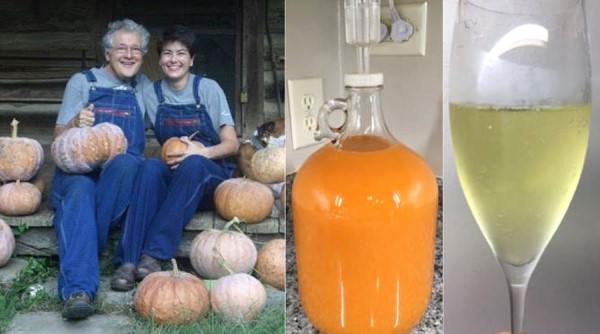
Pumpkin Liqueur
Though not quite a ferment, pumpkin-infused liqueur uses alcohol to preserve pumpkin indefinitely. In the end, strain out the pumpkin for a flavor-infused cocktail, or blend up the whole thing together for a thick cocktail base for pumpkin daiquiris.
While this isn’t a practical way to preserve a lot of pumpkins, a few small pumpkins diced up into a half-gallon mason jar and covered with vodka, rum or brandy would go a long way towards spreading a bit of holiday cheer…
Canning Pumpkin
According to the National Center for Home Food Preservation,
“Canning pumpkin butter or mashed or pureed pumpkin is NOT recommended. Home canning is not recommended for pumpkin butter or any mashed or pureed pumpkin or winter squash.”
Because pumpkin and other winter squash are a low acid food, they can promote the growth of Clostridium botulinum, which is a strain of bacteria that can cause the illness botulism. The puree is so thick that there’s no way to ensure that heat reaches the core of your mashed pumpkin and kills the bacteria that could be inside. Not in a water bath or pressure canner. Don’t even try it!
I’ll admit…I did try canning pumpkin puree. My roommate was dead set on it, and she found instructions for canning pumpkin puree somewhere.
If I remember right, she kept her dial gauge pressure canner at 14 pounds pressure for around 90 minutes? Basically forever if you’ve ever used a pressure canner. Pressure canning chicken or turkey takes less time and pressure than that!
Since it’s not an approved technique, I have no idea if it’s even a “safe” canning recipe. Either way, the puree that came out of the canner looked horrible.
The pumpkin completely separated, and there was a thick layer of pumpkin pulp at the bottom and several inches of liquid pumpkin juice at the top. Not exactly appetizing.
While canning pumpkin puree isn’t a great idea, canning cubed pumpkin actually works just fine. The cubes heat evenly in the canning jars, and they hold together surprisingly well.
When it comes time to use them, just strain out the water and mash the cooked pumpkin cubes. Believe me, it works a lot better than trying to can pumpkin puree!
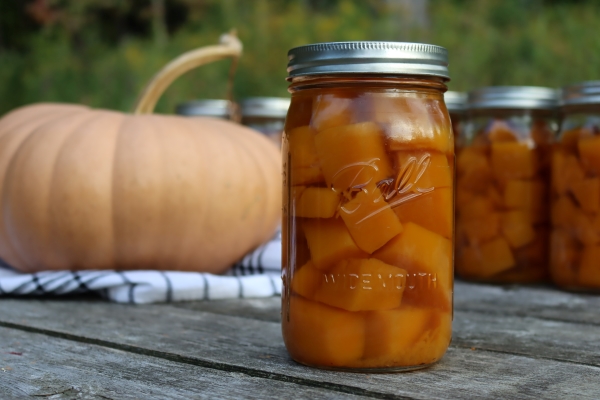
Canning Pumpkin Soup
There are quite a few tested recipes for canning pumpkin soup, and soup with other types of winter squash like butternut. All types of winter squash can be used interchangeably in soup canning recipes.
Keep in mind that you cannot puree the pumpkin in canning recipes, even soup canning recipes, and if you want a smooth soup you’ll have to can the soup in chunks and then puree it at serving time.
Ball canning tested a recipe for Thai Coconut Pumpkin Soup that’s absolutely delicious, and it’s like a cross between a soup and a curry. The coconut milk is added from a can at serving.
Beyond that, there are a number of other pumpkin and butternut squash soup canning recipes. I’m particularly fond of pumpkin and white bean soup.
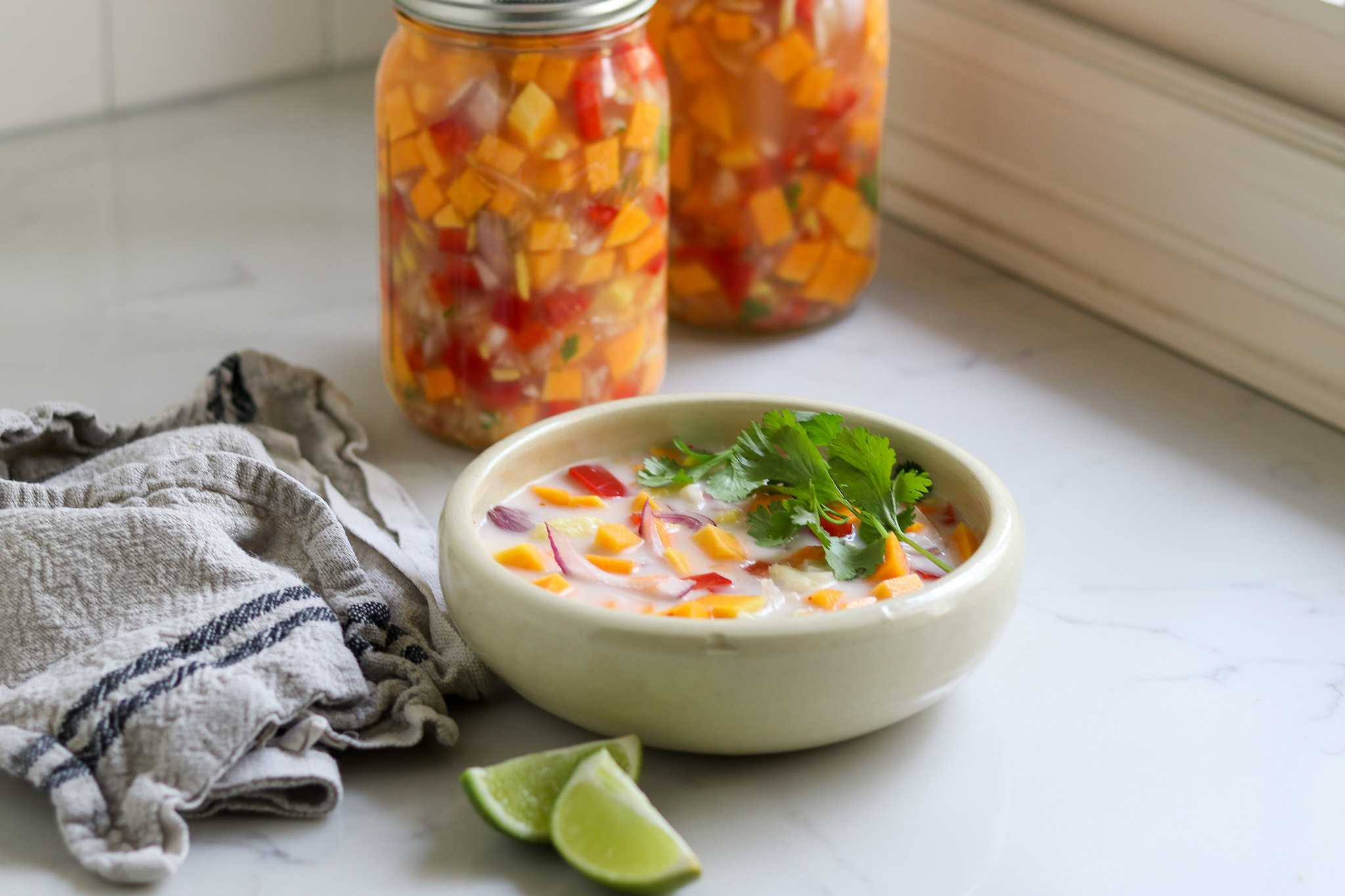
Canning Pumpkin Pickles
There’s actually one more sneaky way to can pumpkin…pumpkin pickles. While cubed pumpkin must be pressure canned since it’s a low acid fruit, the addition of vinegar to pickle pumpkin means that you can water bath can pumpkin pickles.
But what do pumpkin pickles taste like? And how on earth do you use them?!?! According to Mountain Feed Supply, where I found this pumpkin pickles recipe:
“If you’re a fan of pumpkin curry, you’re halfway to loving this recipe already….Dense and brilliant, sweet and tangy, these orange nuggets walk the line between sweet and savory, with a little spice to boot. Picture them as part of a cheese plate, as a Thanksgiving condiment, or in a salad with arugula, cranberries, and goat cheese.”
Canning Pumpkin Chutney
Similar to pumpkin pickles, pumpkin chutney is a fall relish preserved with vinegar so that it’s safe for water bath canning. This pumpkin chutney recipe from the New York times actually doesn’t include water bath canning (though I’d suggest it for extra safety).
Even without sealing the jars through water bath canning, the recipe says that pumpkin chutney “can be stored unopened at room temperature for up to three months.”
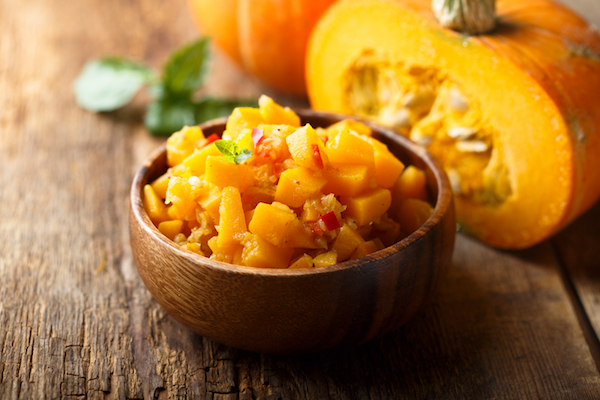
More Fall Preserving Inspiration
Looking for more ways to preserve the bounty this fall? Read on…
- 100+ Canning Recipes From A to Z
- 100+ Dehydrator Recipes
- 20+ Ways to Preserve Eggs
- 30+ Ways to Preserve Apples
- 20+ Ways to Preserve Lemons
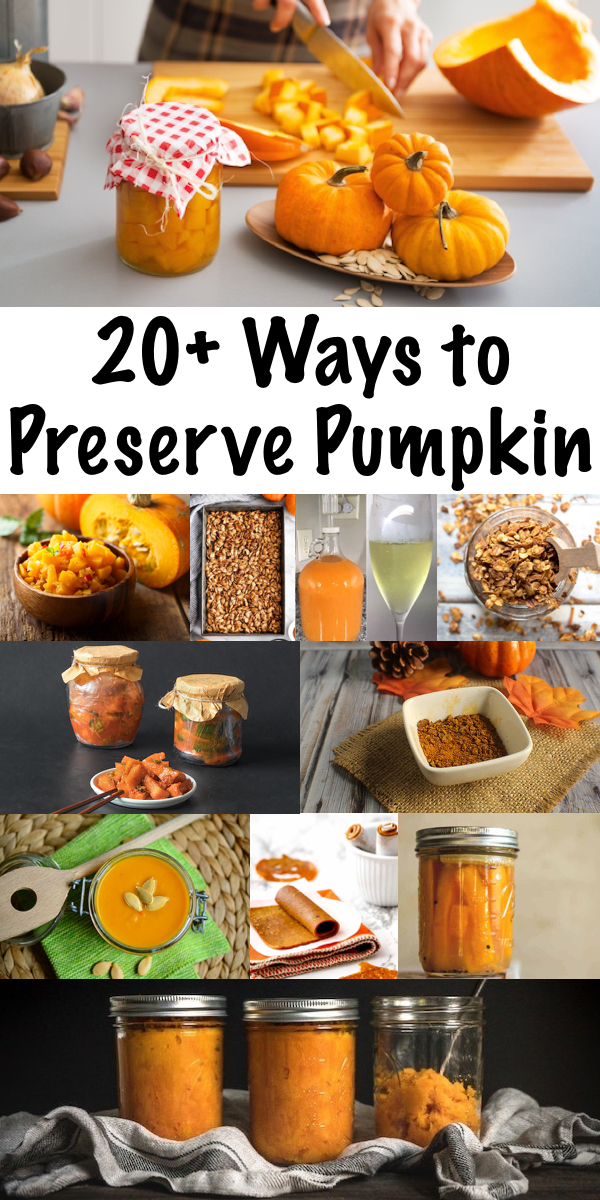

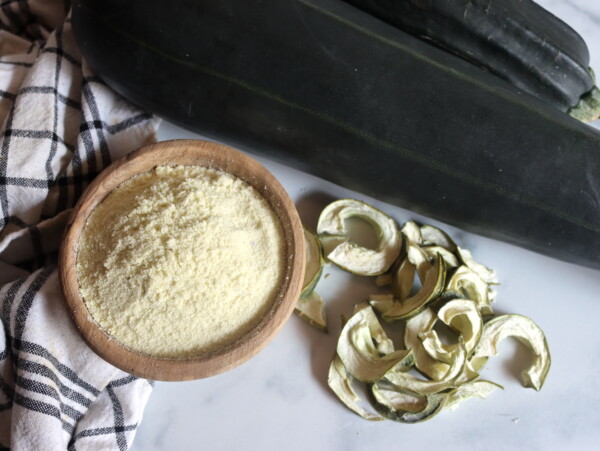


For the pumpkin-infused liqueur use the stringy insides instead of the pumpkin meat. It often has more flavor, and you can save the meat for other things.
I have to give you a thumbs up on your very comical and descriptive advise on this post. I throughly enjoyed reading this article.
In the Great Smoky Mountains, pumpkin was candied, both for a treat and to use in mincemeat. It’s far better than citron.
A book on midwifery in 1700’s New England mentioned making pumpkin vinegar.
Jack o’lantern pickles are great. Use your favorite spicy sweet pickle recipe.
Wonderful thank you! I’ll look into those and add the recipes when I update this post later on. Candied pumpkin sounds great, and I’m not a fan of citron, but I bet candied pumpkin would be amazing as a substitute.
There are so many pumpkin ideas that I’ve never thought of included here– pumpkin powder? Wow! Thanks for including my pumpkin fruit leather. Pinning and sharing on FB to keep these great ideas going. Can’t wait to try some of them!